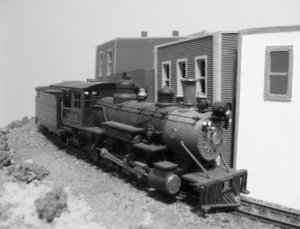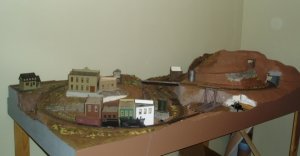N
You are using an out of date browser. It may not display this or other websites correctly.
You should upgrade or use an alternative browser.
You should upgrade or use an alternative browser.
I like it!
Nice photo! I love how you got the engine going 'round a curve there!:thumb: However, the imediate area around the train looks kinds bare. You need some people or trees or something. Is this on the edge of a layout or something?
Nice photo! I love how you got the engine going 'round a curve there!:thumb: However, the imediate area around the train looks kinds bare. You need some people or trees or something. Is this on the edge of a layout or something?
Well it's outside frame, which means that you score bonus points as far as I'm concerned. You see, I hate inside frame with a passion, LOL. 
I take it that this is HOn3?
I take it that this is HOn3?
N
nachoman
yeah, it's a roundhouse outside frame. I've got an inside frame as well, but needs to be put back together. And yeah, it's the edge of the laout so behind the train is blank wall
N
nachoman
So it's a work in progress then. Good, keep us updated!
And if I were you, I'd leave that inside frame engine in pieces.
And if I were you, I'd leave that inside frame engine in pieces.
It's amazing what can be done in small spaces...!!! Good job...! !:thumb:
Now, can someone 'splain this business with the "outside" frame??
Now, can someone 'splain this business with the "outside" frame??
steamhead said:It's amazing what can be done in small spaces...!!! Good job...! !:thumb:
Now, can someone 'splain this business with the "outside" frame??
According to a rather angry and pointed commentary by one of the oldtimers on this forum, w are no longer supposed to ask questions if the answers are either available by searching this forum, or from Google.
Personally, I have seen this comment numerous times in otherwise decent reference books, and I have no idea what the difference is, either. Neither does Google, which does give me links to other frames, such as picture frames, but thats Google for you - the lowest common denominator search engine.
steamhead said:It's amazing what can be done in small spaces...!!! Good job...! !:thumb:
Now, can someone 'splain this business with the "outside" frame??
According to an angry and pointed remark by one of the forum oldtimers, we are not supposed to ask questions any longer until we have exhaused all possible alternative avenues.
OTH, I read any number of books that use this term and I have no idea what it means either, and neither does Google.
steamhead said:It's amazing what can be done in small spaces...!!! Good job...! !:thumb:
Now, can someone 'splain this business with the "outside" frame??

This locomotive is outside frame. Note that the connecting rods are connected to CRANKS rather than directly to the wheels themselves. Between the cranks and the wheels is the chassis frame. The frame is the part that sits on the axles, and is often where all the suspension is.

This locomotive from our friend at the Pacific Coast Air Line is inside frame. Note how there are no cranks, and that the frame is between the wheels, rather than the wheels being between the frames. On these locomotives, the connecting rods are connected directly to the wheels.
Aside from the aesthetics, there is a sound reason for outside frame usage. It is more stable.
While the stability of narrow gauge equipment is inherently questionable ( the narrower the base, the less stable the object, with respect to rolling over), using an outside frame does widen the base, with respect to the center of gravity, and decreases the tendancy of the equipment to roll/tip over.
That said, narrow gauge right of ways need to be just a bit wider, where outside frame locos are used. On a 3' gauge, cylinder centers are typically 6' for an inside frame loco, and 8'-6" for an outside frame loco. The MDC locos conform to the typical cylinder spacing
(8'-6" is not untypical for a standard gauge loco). I have an inside frame 2-8-2, and two inside frame 2-6-6-2s, but I have to admit, my preference is outside frame.
While the stability of narrow gauge equipment is inherently questionable ( the narrower the base, the less stable the object, with respect to rolling over), using an outside frame does widen the base, with respect to the center of gravity, and decreases the tendancy of the equipment to roll/tip over.
That said, narrow gauge right of ways need to be just a bit wider, where outside frame locos are used. On a 3' gauge, cylinder centers are typically 6' for an inside frame loco, and 8'-6" for an outside frame loco. The MDC locos conform to the typical cylinder spacing
(8'-6" is not untypical for a standard gauge loco). I have an inside frame 2-8-2, and two inside frame 2-6-6-2s, but I have to admit, my preference is outside frame.
sumpter250 said:Aside from the aesthetics, there is a sound reason for outside frame usage. It is more stable.
While the stability of narrow gauge equipment is inherently questionable ( the narrower the base, the less stable the object, with respect to rolling over), using an outside frame does widen the base, with respect to the center of gravity, and decreases the tendancy of the equipment to roll/tip over.
I think what you mean is that outside frame produces a lower center of gravity, by giving additional weight lower down. This is more of a traction advantage rather than one of stability. It doesn't widen the base in an effective sense, because the wheels are still the same distance apart. The stability difference between O/F and I/F locomotives here is pretty negligable. In this sense, an inside frame locomotive is actually more stable because it's usually narrower. Outside frame however allows you to accomodate a larger boiler and larger cylinders, thus increasing the weight and therefore adhesion.
The thing with trains is that the physics aren't what the lay man usually expects. The instability of narrow gauge is more of a myth than a fact - people who believe this usually don't take into account that trains use weight to keep them pinned to the rails (adhesion, as I mentioned earlier). This is as opposed to (automobile) cars (with which people often have them confused), which use center of gravity to keep them from rolling over when cornering. So long as the weight above the wheels is greater than the weight either side of them, then it's stable, so long as it doesn't do anything crazy. The only reason a narrow gauge locomotive would roll is if it attempted a very sharp turn at high speed, and the weight shifted (water in the boiler, plus coal in tender). Generally when a locomotive attacks a corner when it's moving too fast, it will just either break the tracks and carry on going forward, or will jump off them and carry on going forward. Usually after doing that it will roll, because in most cases it had already started cornering by the time it had started putting excess stress on/started leaving the track.
The only other circumstance in which I've seen a narrow gauge locomotive roll onto it's side was due to poorly laid track, which is/was the most major failing of narrow gauge railroads worldwide. This is usually the result of underfunded permanent way departments, which is caused by the mentality among operators that narrow gauge produces significant savings in PW construction and maintenance costs, and therefore funding to that department can be cut without consequence.
The most important thing to remember, is that in terms of balance, the working surface is the part of the locomotive that is in contact with the ground. Making it wider or narrower doesn't change the fact that the wheels are only 2 to 3 foot apart. It does however mean that when it starts to tilt, it's more likely to roll in that direction. However, contrary to popular belief, it's not as easy to get a NG locomotive to tip as people might think. For a start, the suspension is trying to stop you from doing just that, and also the sheer weight of the thing would prefer it to be bolt upright at all times. Since it's more fuel effficient to drive like your grandmother, there's no need to worry about tilt during high speed cornering.
I'm sure you knew all this already, but I felt like stretching my brain a bit. :thumb: Also some of this may be of interest to people browsing the forum in general.
N
nachoman
i think whether IF or OF may also come down to railroad preference. All of the large D&RGW 2-8-2s were outside frame. East Broad top's 2-8-2s were all inside frame. Sumpter valley had mostly inside frame as well as White Pass. Colorado and southern and Rio Grande southern were mostly inside frame locos, but those railroads really don't count because they did not puchase any new locomotives after 1900 (Outside frame locos were first made about 1900). And the largest U.S. 3' gauge locomotives, the Uintah 2-6-6-2ts were inside frame.
kevin
kevin
nachoman said:(Outside frame locos were first made about 1900).
Not so, the outside frame design has been around since well before 1900.
Now that, I didn't know. What locomotive, and for which railroad, was the first outside frame delivered?the outside frame design has been around since well before 1900.
N
nachoman
The crystal river railroad had some built in 1900 and 1903. the Morenci Southern in arizona in 1903. Those are the earliest I know of.
kevin
kevin
sumpter250 said:Now that, I didn't know. What locomotive, and for which railroad, was the first outside frame delivered?
I'm not sure exactly, but I know that it's old. The oldest that I know of is Pentewan, a Manning Wardle 0-6-0 tender locomotive, which was built in 1873. I know that by then it was a pretty standard design for narrow gauge locomotives in the UK. Trevithick's Penydarren, one of the first locomotives ever built, was built in 1803. So I'd say that they probably first came into common use in the late 1850s.
pentewan 2'-6"gauge 0-6-0 that ran on the 4 mile Pentewan railway. They also had a Manning Wardle 0-6-2 st Canopus. Perhaps the origin of your screen name?
sumpter250 said:pentewan 2'-6"gauge 0-6-0 that ran on the 4 mile Pentewan railway. They also had a Manning Wardle 0-6-2 st Canopus. Perhaps the origin of your screen name?
Yes it is! I was wondering when someone would spot that. :thumb: The trackbed of the old Pentewan railway runs past the end of my back yard, about 10 meters from my house.



